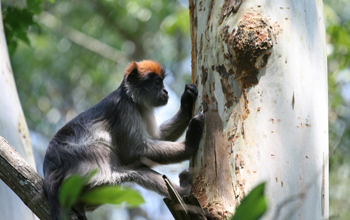Multimedia Gallery
Ugandan Red Colobus Monkey
A Ugandan red colobus monkey (Procolobus rufomitratus) eating nonnative eucalyptus grandis bark in Kibale National Park. This plant food was one of three staple foods of the red colobus that was found to have estrogenic activity. Consumption of estrogenic plants was found to be related to altered hormone levels (estradiol and cortisol) and behavior (grooming, aggression and mating) in adult males during an 11-month field study. The study, led by researchers at the University of California, Berkeley, is the first to observe a connection between plant-based estrogenic compounds, or phytoestrogens, and behavior in wild primates, and could shed light on the role of diet in human evolution.
"It's one of the first studies done in a natural setting providing evidence that plant chemicals can directly affect a wild primate's physiology and behavior by acting on the endocrine system," said Michael Wasserman, lead author of the study. "By altering hormone levels and social behaviors important to reproduction and health, plants may have played a large role in the evolution of primate--including human--biology in ways that have been underappreciated."
The research was supported by a National Science Foundation Gradate Research Fellowship, which assisted with the field research costs, and a Doctoral Dissertation and Improvement grant (BCS 08-23651), which supported the hormone analyses.
For more information, see the UC-Berkeley news story Eating estrogenic plants alters hormones in monkeys, may increase aggression and sex. (Date of Image:July 2007)
Credit: Julie Kearney Wasserman
Images and other media in the National Science Foundation Multimedia Gallery are available for use in print and electronic material by NSF employees, members of the media, university staff, teachers and the general public. All media in the gallery are intended for personal, educational and nonprofit/non-commercial use only.
Images credited to the National Science Foundation, a federal agency, are in the public domain. The images were created by employees of the United States Government as part of their official duties or prepared by contractors as "works for hire" for NSF. You may freely use NSF-credited images and, at your discretion, credit NSF with a "Courtesy: National Science Foundation" notation.
Additional information about general usage can be found in Conditions.
Also Available:
Download the high-resolution JPG version of the image. (1.1 MB)
Use your mouse to right-click (Mac users may need to Ctrl-click) the link above and choose the option that will save the file or target to your computer.



